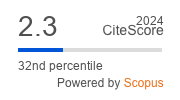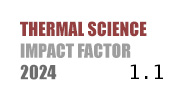THERMAL SCIENCE
International Scientific Journal
PFC/FLAC 3-D COUPLED FLEXIBILITY FOR NATURAL GAS HYDRATE NUMERICAL SIMULATION TRIAXIAL EXPERIMENTAL STUDY
ABSTRACT
In this study, based on the PFC-FLAC discrete-continuous coupled analysis method, we constructed a model of gas hydrate-bearing sediments (GHBS) and conducted triaxial compression numerical simulation experiments. The results show that high confining pressure (>5 MPa) destroys the cementation of hydrate, and the stiffness of GHBS specimens increases with increasing confining pressure. The strength and stiffness of highly saturated (>40%) GHBS specimens increase with the increase of saturation, but the destructive brittleness increases as well. In terms of microscopic contact force, the enclosing pressure effect inhibits the particle motion and the GHBS specimens show anisotropy after loading damage. The results of this study contribute to a better understanding and prediction of the macroscopic and microscopic mechanical properties of gas hydrate sediments, which is of great significance for the safe and efficient exploitation of gas hydrates.
KEYWORDS
PUBLISHED ONLINE: 2025-06-01
THERMAL SCIENCE YEAR
2025, VOLUME
29, ISSUE
Issue 2, PAGES [1345 - 1350]
- Li, F., et al., Formation Mechanism of Core Discing During Drilling Under Deep In-Situ Stress Environment: Numerical Simulation And Laboratory Testing, Journal of Central South University, 30 (2023), 10, pp. 3303-3321
- Yang, Y. K., et al., Laboratory Simulation of Natural Gas Hydrate Formation and Low Disturbance Drilling, Thermal Science, 28 (2024), 4B, pp. 3547-3552
- Miyazaki, K., et al., Triaxial Compressive Properties of Artificial Methane-Hydrate-Bearing Sediment, Journal of Geophysical Research-Solid Earth, 116 (2011), IDB06102
- Hyodo, M., et al., Mechanical and Dissociation Properties of Methane Hydrate-Bearing Sand in Deep Seabed, Soils and Foundations, 53 (2013), 2, pp. 299-314
- Kajiyama, S., et al., Experimental Investigation on the Mechanical Properties of Methane Hydrate-Bearing Sand Formed with Rounded Particles, Journal of Natural Gas Science and Engineering, 45 (2017), Sept., pp. 96-107
- Jiang, M. J., et al., The DEM Analysis of Geomechanical Properties of Cemented Methane Hydrate-Bearing Soils at Different Temperatures and Pressures, International Journal of Geomechanics, 16 (2016), 3, ID04015087
- Jiang, M. J., et al., Study of Mechanical Behavior and Strain Localization of Methane Hydrate Bearing Sediments with Different Saturations by a New DEM Model, Computers and Geotechnics, 57 (2014), Apr., pp. 122-138
- You, Z. S., et al., A Numerical Investigation on the Mechanical Properties of Hydrate-Bearing Sand Using Distinct Element Method, Journal of Natural Gas Science and Engineering, 96 (2021), ID104328
- Dou, X. F., et al., The 3-D DEM Modelling on Mechanical Weakening of Gas Hydrate-Bearing Sandy Sediments During Hydrate Dissociation, Computers and Geotechnics, 154 (2023), 17, ID105116
- Brugada, J., et al., Discrete Element Modelling of Geomechanical Behaviour of Methane Hydrate Soils with Pore-Filling Hydrate Distribution, Granular Matter, 12 (2010), 5, pp. 517-525
- Wang, N. N., et al., Macro-Micro Mechanical Behavior Research on Gas Hydrate Bearing Coal Based on Parallel Bonding Model, Journal of China Coal Society, 49 (2024), S1, pp. 314-326
- Tizpa, P., et al., The PFC/FLAC 3-D Coupled Numerical Modelling of Shallow Foundations Seated on Reinforced Granular Fill Overlying Clay with Square Void, Computers and Geotechnics, 161 (2023), ID105574
- Yan, R. T., et al., Constitutive Model for Gas Hydrate-Bearing Soils Considering Hydrate Occurrence Habits, International Journal of Geomechanics, 17 (2017), 8, ID04017032
- Gou, H., et al., Numerical Analysis of Perforated Symmetric Fissures on Mechanical Properties of Hole-Containing Sandstone, Applied Sciences-Basel, 13 (2023), 15, 16, ID8780
- De La Fuente, M., et al., Modelling Methane Hydrate Saturation in Pores: Capillary Inhibition Effects, Energies, 14 (2021), 18, ID5627
- Wei, D., et al., Estimation of Gas Hydrate Saturation Regarding the Hydrate Morphology in Hydrate-Bearing Sands in the Qiongdongnan Basin, South China Sea, Pure and Applied Geophysics, 180 (2023), 7, pp. 2757-2773
- Lee, Y., et al., Influence of CH4 Hydrate Exploitation Using Depressurization and Replacement Methods on Mechanical Strength of Hydrate-Bearing Sediment, Applied Energy, 277 (2020), ID115569
- Xu, Z. H., et al., A Parameter Calibration Method for PFC Simulation: Development and A Case Study of Limestone, Geomechanics and Engineering, 22 (2020), 1, pp. 97-108

